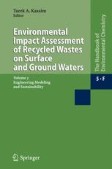Search
Search Results
-
Improving the absorption load, high viscosity, and regeneration efficiency of CO2 capture using a novel tri-solvent biphasic solvents of TETA-AMP-1DMA2P
Currently, biphasic solvents are receiving more attention for CO 2 capture due to their energy-saving potential. Whereas, most of the current biphasic...

-
Novel biphasic amino-functionalized ionic liquid solvent for CO2 capture: kinetics and regeneration heat duty
Amino-functionalized ionic liquid biphasic solvents present excellent absorption capacity, regeneration ability, and energy consumption savings,...

-
Empirical and Mechanistic Modeling of Release Kinetics of Heavy Metals and Their Chemical Distribution in the Rhizosphere and Non-rhizosphere Soils Under Vegetable Cultivation
Biochemical processes in the rhizosphere affect the availability and distribution of heavy metals (HMs) in various forms. Rhizosphere soil (RS) and...

-
Effect of Soil Type and Temperature on Persistence and Dissipation Kinetics of a New Readymix Formulation of Fomesafen + Quizalofop-ethyl
The research portrays the fate of a new herbicide mixture of fomesafen and quizalofop-ethyl. The soil samples viz. red lateritic soil (A), coastal...

-
A Case Study in the Application of Environmental Chemodynamic Principles for the Selection of a Remediation Scheme at a Louisiana Superfund Site
This chapter studies the application of chemodynamic principles to select a remediation scheme at a Louisiana Superfund site (Petro Processors, Inc...
-
Non-targeted impact of cyantraniliprole residues on soil quality, mechanism of residue degradation, and isolation of potential bacteria for its bioremediation
Cyantraniliprole (CY), an anthranilic diamide insecticide widely used in grape farming for controlling various sucking pests, poses ecological...

-
Comparison of sunlight-AOPs for levofloxacin removal: kinetics, transformation products, and toxicity assay on Escherichia coli and Micrococcus flavus
Levofloxacin (LFX) is a widely used antibiotic medication. Persistent traces of LFX in water and wastewater may induce bacterial resistance....

-
Potential use of nanoparticles produced from byproducts of drinking water industry in stabilizing arsenic in alkaline-contaminated soils
The stabilization of heavy metals in soils is considered a cost-effective and environmentally sustainable remediation approach. In the current study,...

-
Degradation of imazethapyr in soil: impact of application rate, soil physicochemical properties and temperature
A dissipation study of pesticides in soil is essential as it is a major sink for bulk of globally used pesticides. Soil properties, temperature and...

-
Experimental strategies to measure the microbial uptake and mineralization kinetics of dissolved organic carbon in soil
Soil organic matter turnover rates are typically estimated from mass loss of the material over time or from on rates of carbon dioxide production. In...
-
Evaluating plant residue decline data with KinGUII and TREC: results from case studies involving also non-SFO kinetic models
BackgroundFoliage residue decline data are used to refine the risk assessment for herbivorous birds and mammals foraging in fields treated with plant...

-
Molecular Characterization of Humic Acid Fractions and their Effect on the Adsorption of Cr(VI) by Goethite
Humic acid (HA) is a supermolecule consisting of a variety of components, has a significant influence on the geochemical behaviors of Cr(VI), and is...

-
Bioaccumulation of Bis-(2-ethylhexyl)-3,4,5,6-tetrabromophthalate and Mono-(2-ethylhexyl)-3,4,5,6-tetrabromophthalate by Lumbriculus variegatus
The brominated flame retardant bis(2-ethylhexyl)-3,4,5,6-tetrabromophthalate (TBPH) is used widely in consumer items including polyurethane foam used...

-
Trihexyl tetradecyl phosphonium bromide as an effective catalyst/extractant in ultrasound-assisted extractive/oxidative desulfurization
Phosphonium-based ionic liquid (PIL) has been used as a catalyst and extractant. Here, the PIL, trihexyl tetradecyl phosphonium bromide ([THTDP]Br)...

-
Study of chromate (VI) removal via sequential combined fenton’s process and adsorption by nano-magnesium oxide-modified wood biochar for tannery wastewater treatment
This study explored the combined treatment approach to facilitate the treatment of tannery wastewater through Fenton's reagents and batch adsorption...

-
Research on carbon dioxide capture materials used for carbon dioxide capture, utilization, and storage technology: a review
In recent years, climate change has increasingly become one of the major challenges facing mankind today, seriously threatening the survival and...

-
Study of coliforms and Clostridium bacteria inactivation in wastewaters by a pilot photolysis process and by the maturation lagoons of a low-cost nature-based WWTP
The inactivation processes of coliform bacteria (total and fecal) and sulphito-reducing Clostridium bacteria (vegetative species and spores) in water...

-
Photocatalytic degradation of paraquat dichloride in the presence of ZnO.WO3 composite
The study reports the synthesis of a series of ZnO.WO 3 composites in different mole ratios of 40:60, 60:40, 80:20 and 20:80. They were characterized...

-
Recent advances, challenges, and perspectives on carbon capture
Carbon capture, utilization and storage (CCUS) technologies play an essential role in achieving Net Zero Emissions targets. Considering the lack of...

-
Biodesulfurization of refractory sulfur compounds in petro-diesel by a novel hydrocarbon tolerable strain Paenibacillus glucanolyticus HN4
One of the main precursors of air pollution and acid rains is the presence of the recalcitrant thiophenic compounds, for example dibenzothiophene...

